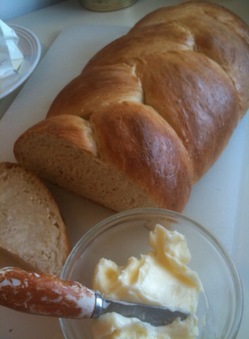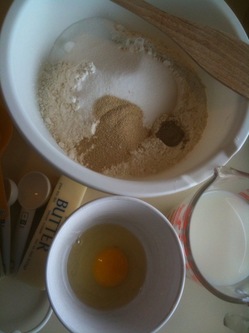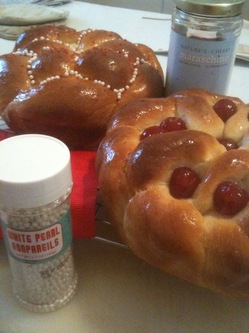Home-baked bread provides comfort from the cold
When the depths of winter threaten to undermine all hope and sanity, I turn to carbs for comfort. Specifically, I turn to bread.

Home-made breads, like this Finnish classic called pulla, are inexpensive to make. Slightly sweet, it is served with butter to accompany coffee.
Farnham | Contributor
The best of it, to my mind, comes in the form of yeast-risen, carbohydrate comfort also loaded with history and culture, aromas and memory. Whether it's challah, baguette, whole wheat, raison bread or cinnamon swirls, these loaves can represent home, warmth, safety, creativity, faith, grandparents, caregivers, and more. For me, bread is connected to my own notions of motherhood. I have twice had buns in the oven, after all. I bake for my children and dream of making bread with grandchildren someday.
Most of us have a favorite bread. The taste is loaded with feeling. Mine means most to me in winter, the time of year it was baked most often, warming up the house. It can be traditional, spiritual in meaning, perhaps baked during religious or cultural holidays, for family or community celebrations.
Bread is truly love for many of us and can represent our connection to others. It is meant to be broken and shared, a fiber which reaches back generations and across city blocks and oceans, spanning neighborhoods and whole cultures, conquering spans of great time and even greater distances.
When my family and I first arrived here about nine years ago, we had moved a reasonably great distance ourselves. And as a Canadian coming to the US from a northern Prairie city, I was shocked at the price of bread in the much smaller, mid-western community of Ann Arbor.
On our first grocery outing here, my husband and I spotted a loaf of what we soon leaned to call artisan French bread, deemed perfect comfort for our two young children and ourselves. It looked like the bread we always bought at home. It smelled like the bread we always bought at home. But it cost twice what we would have paid in our local, Edmonton grocery store. In fact, even more than that if the currency rates of the day were considered, which, believe me, they were every single time I opened my wallet in those early years here. On a $0.63 dollar, this unassuming loaf of bread cost more than a roast of beef. It seemed outrageous.
I still find cause to shake my head at bakery counters, years later. To us, it was mildly offensive that this most basic, most humble of items should be priced to out of reach of people like us.
The result of this bakery-induced sticker shock, was a return to bread-making for my family. My two year-old's corn-allergy precluded less expensive, mass-produced bread from the supermarket - all loaded with ingredients like high-fructose corn syrup, corn flour, corn oil and/or corn meal - and virtually all lower cost, in-store bakery loaves at the time. So, with panty loaded with hard wheat-derrived, Canadian all-purpose flour which had moved with us and a new jar of Fleishman's RapidRise yeast, I set out to bake our daily bread in my 7 x 8 foot kitchen.
There is no more basic prepared food than bread. It spans the globe in one form or another. It consists of flour, water, salt with other ingredients to flavor or aid leavening like sugar, honey or molasses. Sometimes fat - butter, oil, lard - and egg are used. Some use yeast while others do not. Of course, it goes far beyond these ingredients too but these comprise the basic building blocks of most breads. Inexpensive and easy to stock. Even in my space-challenged Village kitchen, we managed to bake bread as we needed it through those especially lean, fellowship-income-only years.
Although my dad, back in my hometown, still makes uber-thrifty sourdough from some creepy bowl of starter kept at the back of the fridge for nearly a decade, my heart belongs to yeast breads. So simple and so luxurious at the same time. And in my case, as a time-crunched, domestic efficiency affection-ado, I love the little jam-sized jar of so-called instant yeast I keep in the fridge door shelf for that not-quite-instant gratification of fresh baked bread.
As January closed, and the grey skies and blue moods began to crowd me in, I turned to a tried and true recipe from my youth. Being born from and raised in a home of Finnish ancestry, I think the cardamom from this bread must run through my veins. It is my favorite, all-time bread, one I leaned to bake not from my mother but from a neighbor from home. It's a cardamom-infused Northern classic known as Finnish coffee bread or Finn bun: pulla. Yupers will know what I'm talking about - I often refer to myself as a Yuper with a Canadian passport - we speak the same language and love the same bread on Saturday afternoons. It's synonymous with warmth, home, winter, Christmas, mummas, and love.
To bake that love-in-a-loaf, all you need can be easily - and inexpensively - purchased. And it all keeps, tightly sealed, in your fridge or pantry.

Pulla ingredients - dry and wet - are assembled separately first, then combined. Butter is kneaded in last. It's a home-made treat with easy-to-find, inexpensive ingredients.
Farnham | Contributor
To get that shiny glaze for the top, a little sugar and fresh or bottled lemon juice combined in a cup or bowl is brushed on just after pulling it out of the oven. Finally, I keep parchment paper on hand for all my baking. I use seasoned, older cookie sheets lined with parchment each time for great baking results.
Check out the full recipe: Ann's Favorite Pulla Recipe - from a fellow Northern Ontario Finn on my blog, Ann of Ann Arbor.
Making bread yourself is a hands-on experience. So, take your jewelry off, wash your hands - and those of any little helpers who may want to join in - and dive right in.
Kneading the dough is fun, especially for kids. Making this together is as much fun as eating it together. It starts out messy and quite sticky but, as you knead the dough, it becomes soft, elastic, and easy to handle. Here's a video demonstration as I knead a batch of dough. This is one-handed-kneading so I can hold my iPhone to take the video. DO try this at home but use two hands instead. It works much better. Ann of Ann Arbor dough kneading demo:IMG_0750.MOV
I enjoy this home-made pulla sliced and served with butter but there is nothing like eating it warm, pulled apart along it's braided edges, dabbed with butter melting in those torn bread fibers. It's a sweet bread so it doesn't need anything sweet to go with it.

Decorated in Valentine's Day style with white pearl-style candies, red decorator sugar and cherries. This sweet dough can be shaped however you like it - have fun with it. These were baked in round cake pans with parchment paper.
Farnham | Contributor
Baking bread at home is an inexpensive way to get all this sensory goodness back into your family's life without breaking the bank. Making it yourself with family, for friends and family, creates a little extra warmth - and love - to provide comfort from the cold.
Ann Farnham is a mother of two, community volunteer and personal organizer with a love of living large and spending little. Follow her at Ann of Ann Arbor.

